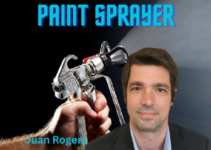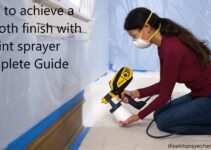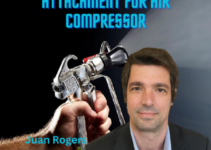Painting is a great way to revamp the look of your home or office. But, if you’re considering using a paint sprayer, there are certain factors you need to consider first.
You need to be sure that the paint sprayer you choose will do the job right, without causing any damage. In this guide, we’ll explore all of the factors that should go into your decision-making process when choosing a paint sprayer.
Spray painting is a great way to get a flawless, even finish on all your projects. Whether you’re planning a do-it-yourself job or taking care of a commercial painting project, choosing the right paint sprayer can make all the difference in the quality of your finished product. There are several factors to take into consideration when making this important decision.
First and foremost, you must consider the type of material that needs to be painted and the size of the job. Different types of spray guns will work best for different materials and applications. The amount you plan to spend will also affect your decision, as well as any applicable regulations related to paint application in your area. Finally, consider any special features or accessories that may make using the spray gun easier for you.
By taking into account these factors before selecting a paint sprayer, you can ensure that your job turns out exactly as planned and with minimal hassle. Keep reading for more information about what characteristics to look for in a paint sprayer and advice about which one might be best for your particular needs.
Explanation of what a paint sprayer is
A paint sprayer is a device that is used to apply paint, lacquers, and other liquids in an even manner. It is an ideal tool for painting large surfaces quickly and evenly.
The paint sprayer operates by atomizing the paint into microscopic particles and spraying them onto the desired surface. This produces a much more consistent finish than when using a traditional brush or roller.
Paint sprayers are often used for large projects where precision and quality of finish is paramount, such as car detailing or construction projects. They can also be used for smaller home DIY projects where speedup of painting work is required.
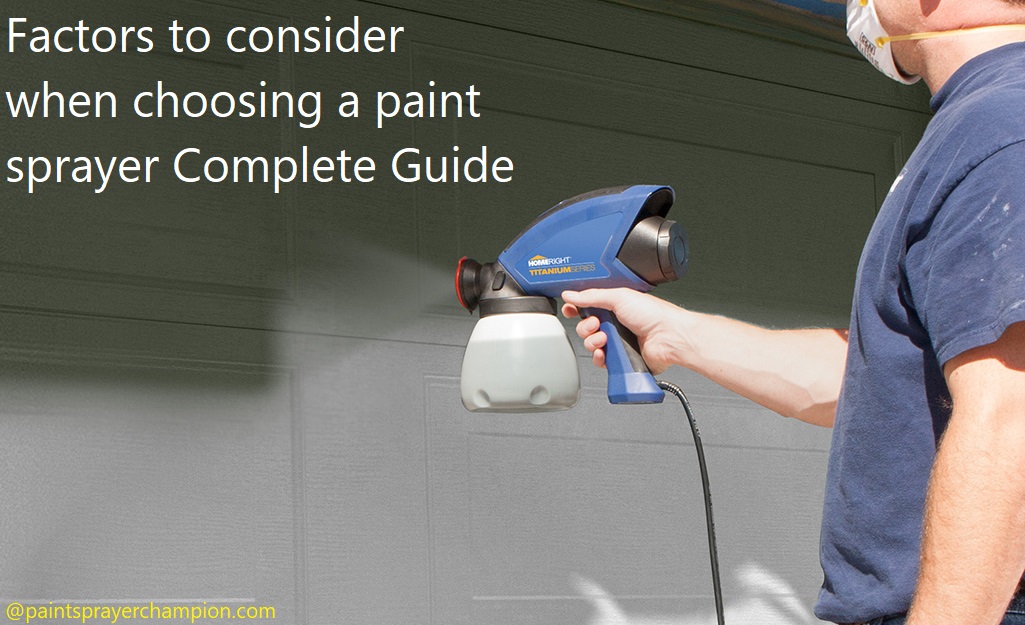
Importance of choosing the right paint sprayer
When considering a paint sprayer, it is important to consider several factors to make sure that you select the right one for the job. It is important to think about the size and type of painting or staining project that you need a sprayer for, as well as the types of surfaces you will be spraying. Other important factors include budget, maintenance needs, portability and air quality considerations.
The size of a project can play an important role in choosing a sprayer. Smaller projects are well-suited to small handheld models while larger projects may require more powerful stationary models with greater capacity paint hoppers. Also consider the surface being sprayed – porous surfaces require less pressure than non-porous surfaces such as wood and metal and therefore need less powerful models. When deciding on your budget, look at both the cost of the equipment itself as well as any maintenance costs or parts that might need replacing down the line.
Portability is another factor to take into account when choosing a paint sprayer. Mobility can make it much easier to use your machine in different locations without having to move it from place to place each time you use it. In addition, consider how simple or difficult it is to clean and maintain your furnishings – some machines are easier than others.
Finally, ensure your safety by looking for products with low emissions and low levels of volatile organic compounds (VOCs). These emission numbers should be clearly marked on product packaging so they can be compared easily before making your purchase decisions.
Overview of the factors to consider when choosing a paint sprayer
Paint sprayers come in a variety of shapes and sizes, and you will want to choose one that best fits your needs. Here are some factors to consider when looking for the best paint sprayer for your particular project:
- Paint output and speed – The amount of paint that a paint sprayer can handle is an important consideration. Many models offer adjustable flow rates, so you can control the amount of paint per minute. Additionally, some systems allow for dual-spray mode where each pass covers twice the area with half the produced overspray.
- Ability to choose nozzles – Selecting a paint sprayer with multiple nozzle sizes gives you more flexibility in how you apply your paint, including the ability to reach difficult corners or patterns of different widths. Some models allow you to switch out nozzles without having to stop and clean up any residual mess created by changing nozzles mid-job.
- Maintenance – Proper maintenance is essential when using any type of spray tool, so opt for one that is easy to care for. Choose a model that allows for quick cleaning and regular checks on clogs or blockages in order to keep air flow through adequate at all times for optimal output levels consistency. Make sure that the expected work environment is compatible with the model chosen as well; high humidity or temperatures will require higher quality materials that may add cost but minimize maintenance frequency requirements or increased risk of breakdowns over time from accelerated rusting or corrosion due to environment fluctuations above acceptable levels recommended by manufacturers.
- Accessories – Many paintsprayers bundles accessories like filters, wands, hoses tube extensions and misters which allow further customization depending on application needs: vary widths quickly change nozzle types ,or even add additional functionality such as air assist features (for larger jobs). Moreover special adapters tailored to industrial applications may be available on some models which can significantly increase comfort while performing certain tasks like scaffolding painting etc…
Power Source
The second factor to consider when choosing a paint sprayer is the power source. Paint sprayers come in either electric or gas-powered varieties. Electric sprayers provide more convenience and control, as they are typically corded so you can move freely around your work area. Electric power also has less maintenance and is cleaner than gas-powered systems, as it does not use oil or exhaust fumes.
Gas-powered paint sprayers are much more portable and do not require a power cord for use, but require more maintenance to keep them well maintained. They also generate more heat which can cause the paint to thicken quickly, making them better suited for large projects that require high output of paint in a short period of time.
Consider the size of your project as well as your budget when selecting your paint sprayer power source.
Electric Paint Sprayers
Electric paint sprayers offer a wide range of spraying capabilities and are useful for both indoor and outdoor projects. The benefits of electric paint sprayers include portability, convenience and relatively less expensive. When deciding on which electric paint sprayer to choose, several factors should be taken into account.
The first factor is the type of project for which the paint sprayer will be used. If a big project is planned, such as painting an entire house or a large piece furniture, then an electric paint sprayer with higher PSI pressure might be appropriate. For mid-size projects like fence staining or trim painting, a medium PSI pressurized electric paint sprayer should suffice. Small projects would best utilize a lightweight handheld electric paint sprayer with lower PSI pressure.
An additional factor is the capacity of the tank available on the device. It is important to consider how much one will need to refill in order to complete their desired job with minimal interruption or break time needed for cleanup and refilling between uses. For large projects needing bigger tanks and greater volume of coverage, look at the option available with larger capacity tanks like an HVLP (High Volume Low Pressure) system or traditional airless systems.
Finally, always keep in mind noise levels when selecting an electric paint sprayer as larger more complex models tend to have a considerably louder noise output compared to smaller simpler models that usually operate at lower decibels during operation. Depending on where it will be used – indoors or out – you may need to take into consideration sound levels when making your selection.
Cordless Paint Sprayers
Cordless paint sprayers are becoming increasingly popular due to the ease of use and convenience they offer compared to corded models. They are usually powered by batteries, which allows them to be used anywhere with no worries about cords getting tangled or unplugged. Generally speaking, cordless paint sprayers have shorter runtimes than corded models and may have limited settings, but they are still suitable for most painting tasks.
Considerations for choosing a cordless paint sprayer include:
- Cost: Cordless units tend to be more expensive than their corded counterparts.
- Portability: With no cords to worry about, you can easily move these units from room to room or even from one job site to another without any concerns about tripping over or untangling power cables.
- Runtime: Cordless units come with different levels of battery life and may require frequent charging for extended projects.
- Settings: You will want to make sure that the unit you choose has the appropriate settings for your specific project needs. Some models may only have a single setting while others may offer multiple settings such as spray width adjustment and material flow rate control.
- Weight: Most cordless models are relatively lightweight when compared to their corded equivalents since there is no need for power cords and motors which add substantial weight. This makes them ideal for those who need something that is easy to move around on a regular basis.

Gas-powered Paint Sprayers
Gas-powered paint sprayers offer the most power and versatility. They are best suited to outdoor projects such as spraying fences, decks, siding and larger items such as boats or commercial areas. With a gas-powered paint sprayer, you can count on being able to tackle any job without worry of running out of power!
These tools are portable and come with long, adjustable hoses so you can reach even the trickiest spots. Their high PSI output means that you can use thinner paints with ease. When using a gas-powered machine, be sure to have adequate ventilation and use a mask or respirator for safety when painting indoors. Here are some features to bear in mind when choosing between gas-powered models:
-Start Type: Gas powered paint sprayers can come with manual start systems or electric start systems. Electric start makes starting easier but requires access to an electricity outlet while manual start models don’t need an external power source but may require more effort to get them going.
-Weight: Most gas powered models will be quite heavy so consider the weight before purchasing if you need portability.
-Tank Capacity: Larger tanks will require fewer refills when tackling a large job but smaller tanks can be handier for smaller jobs where maneuverability is key.
-Hose Length: Longer hoses allow for more reach; note that different lengths are suitable for both indoor and outdoor projects so selecting the right length is important depending on your needs.
Comparison of each power source
When it comes to choosing a paint sprayer, one of the main factors to consider is the power source. Paint sprayers come in four main varieties — compressed air, electrically powered, battery operated and crank-powered. Each type of power source has pros and cons that should be evaluated prior to purchase.
Compressed Air: Compressed air paint sprayers are the most powerful type and are commonly used in industrial complexes or factories. These machines require a large amount of compressed air, which may not be ideal for residential or small commercial use.
Electric: Electric paint sprayers are less powerful than compressor-powered models, but they offer greater portability due to their lower weight and require less setup time. They do, however, require an electrical outlet close by for plugging in the cord.
Battery Operated: Battery operated paint sprayers typically weigh less than electric models and can provide continuous use with no need for a nearby electrical outlet. However, their run time is limited by their battery life and will need to be recharged regularly when in heavy use.
Crank-Powered: Crank-powered paint sprayers often have many of the same features as electric models but have no need for an external power source such as an electrical outlet or battery pack. However, many consumers find them more challenging to operate due to their manual design.
Capacity and Output
Illustrated capacity and output are the two main factors to consider when choosing a paint sprayer. Illustrated capacity is the amount of paint that the sprayer can store in its reservoir, while output is the volume of paint that it can disperse. A smaller illustrated capacity often means a higher output, in which case it may be suitable for larger projects where more paint is needed, while a larger illustrated capacity allows a lower output. The latter is often preferred for small or medium sized projects as it gives you finer control over how much paint is placed on the surface area.
You should also pay attention to other specifications such as minimum and maximum pressure levels, spray pattern widths and adjustable pressure settings. Additionally, many modern sprayers have adjustable speed settings and special nozzles which selectively control different types of saltwater surfactants used in the painting process. Lastly, there are some models with built-in temperature sensors which improve accuracy in painting on areas with complex contours or shapes.
Explanation of paint capacity and output
Paint capacity and output are two of the most important factors when selecting a paint sprayer. Paint capacity is determined by the amount of paint that can be contained within the sprayer’s reservoir, whereas output describes how much paint is applied to surfaces. These two elements are closely related and need to be considered when choosing a paint sprayer.
Paint capacity is an important aspect to consider as it affects how frequently one must refill the reservoir. Smaller units with lower capacities require more frequent refills while larger and more powerful models allow one to complete bigger projects faster because they hold a larger volume of material and their output rates are higher. For example, some units have tanks that can hold up to 1 gallon of paint while others can handle up to 5 gallons or more. The right choice will depend on the size of your project and how often you’ll need to refuel the tank.
Output describes how much material is sprayed onto objects in a given period of time, usually measured in gallons per hour (GPH). This indicates how effective a unit will be for completing large tasks quickly. Output rates range from .5 GPH for small detail work up to over 12 GPH for high-volume commercial projects such as staining fences or painting decks, walls, exterior siding, and building roofs. Generally speaking, larger jobs require higher volumes of output with shorter dry times between refills or coats of paint or stain, so keep an eye out for models that offer adjustable output settings if needed.
Choosing the right capacity and output for your project
The capacity and output of a paint sprayer relate to the performance levels that you will achieve with your project. It’s important to consider these factors carefully to ensure that you get the best results.
Consider the volume of material that needs to be sprayed. This can help you decide on the ideal size of your paint sprayer as bigger models are usually more appropriate for larger jobs. It’s also important to think about the speed and efficiency that you need, so choose a model with an adjustable speed option if possible.
You should also consider how much paint pressure or air flow is needed for a quality finish. The output pressure should be sufficient enough for fine atomization which gives better control of the particles and improved accuracy when spraying larger areas. To help you make this choice, have look at each product’s performance data before purchasing a particular model.
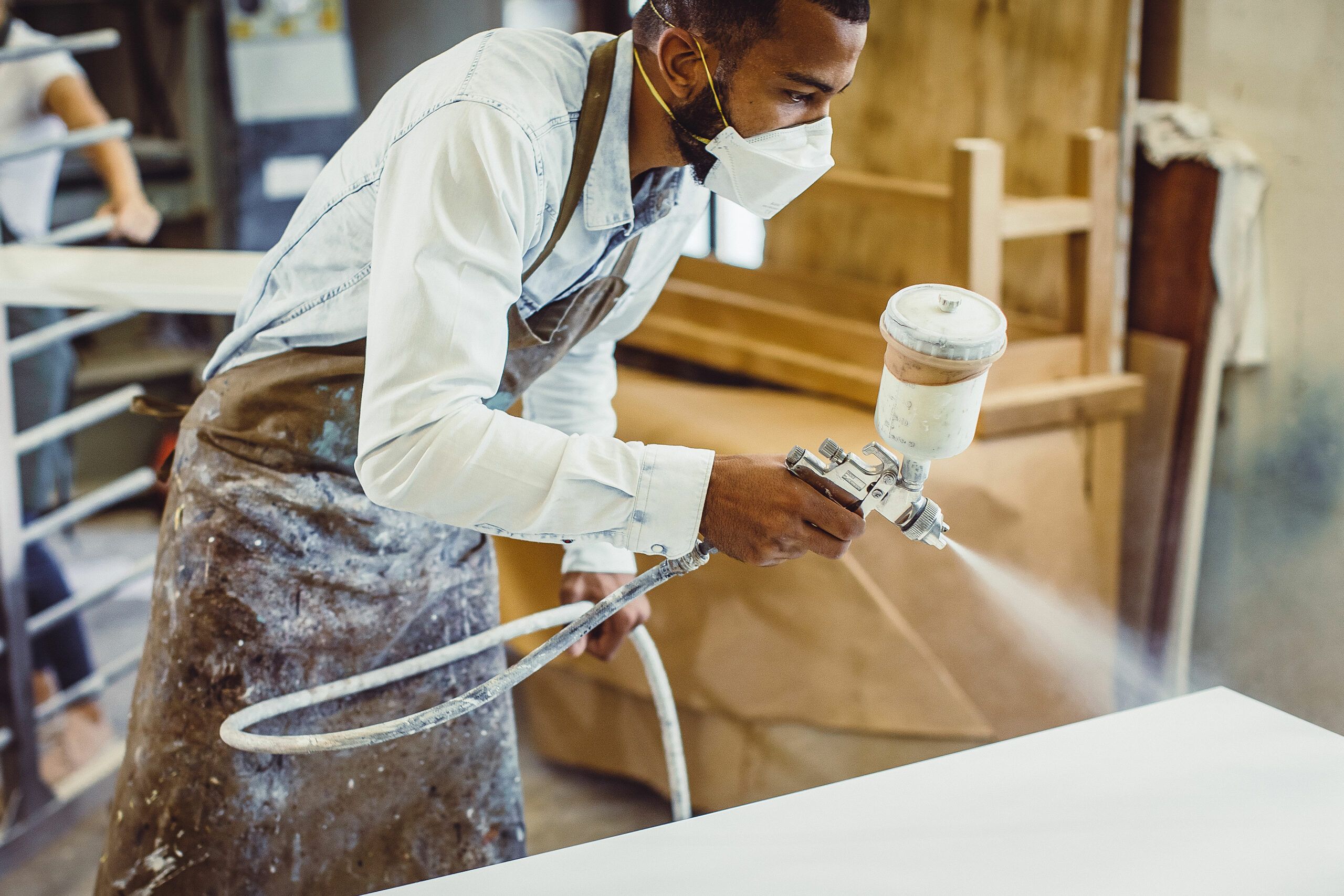
Conclusion
Ultimately, the best paint sprayer for you will depend on your preferences, budget and other factors. Consider the size of your project area, the material and type of paint you’re using as well as any preparatory or post-application steps needed.
If you plan to spray large surfaces on a regular basis, an airless paint sprayer or high-pressure HVLP unit may be your best option. For smaller projects, an air-assisted airless or conventional HVLP may work well. Make sure to factor in the cost of filters, spare parts and maintenance when contemplating the upgrade.
Finally, read reviews from other users and consult with a professional before buying any brand or model of paint sprayer. By doing so, you can confidently select the machine that meets your needs both now and in the future.
FAQ’S
How do I choose a paint sprayer?
Consider factors such as the type of project, size of the surface, type of paint, and your budget.
What are the factors to consider while spray painting?
Factors to consider include the type of surface, type of paint, type of sprayer, pressure settings, and technique.
What do I need to know before using a paint sprayer?
You should know how to properly set up and clean the sprayer, choose the appropriate paint and thinning agent, and practice using the sprayer on a test surface.
Which type of paint sprayer is best?
The best type of paint sprayer depends on the project requirements, but airless and HVLP sprayers are commonly used.
What are the 4 types of paint sprayers?
The four types of paint sprayers are airless, HVLP, compressed air, and handheld.
What pressure is best for spray painting?
The best pressure for spray painting depends on the type of paint and the type of sprayer being used. Generally, it ranges from 1,500 to 3,000 PSI.
What features are common to all types of sprayer?
Common features include a spray gun, paint container, hose, and various settings for controlling the flow and pattern of the paint.
Which paint sprayer is better air or airless?
Both air and airless sprayers have their advantages and disadvantages, so the better option depends on the specific project requirements.
What type of paint sprayer is best for walls?
An airless or HVLP sprayer is typically best for painting walls.
How many types of paint sprayers are there?
There are mainly three types of paint sprayers: airless, HVLP (high-volume, low-pressure), and compressed air sprayers.
See Also:
- Best indoor paint sprayer
- Best sprayer for latex paint
- Best professional paint sprayer
- Best paint sprayer
- Best paint sprayer under $100
